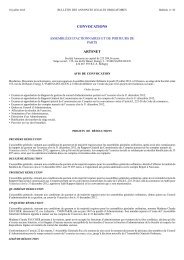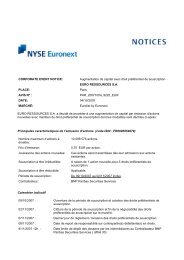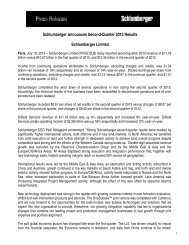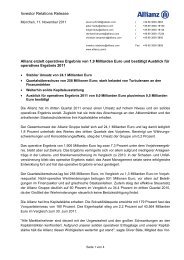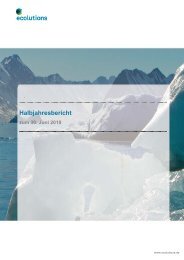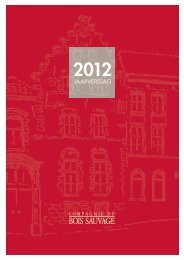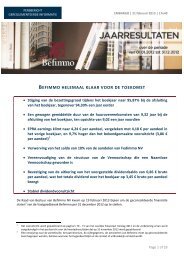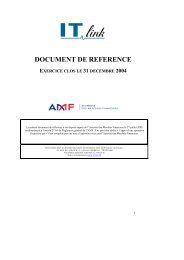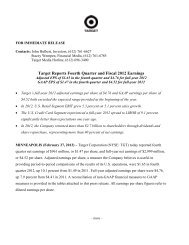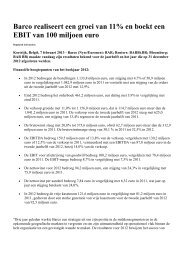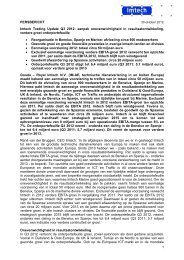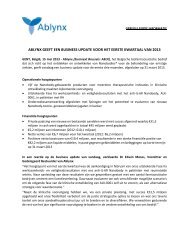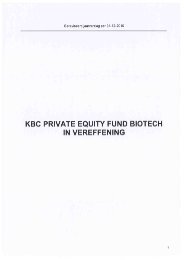FORM 10-Q
FORM 10-Q
FORM 10-Q
Create successful ePaper yourself
Turn your PDF publications into a flip-book with our unique Google optimized e-Paper software.
NOTE 4: INVENTORIES<br />
Inventories consist primarily of raw materials and packaging (which include ingredients and supplies) and finished goods (which include concentrates and<br />
syrups in our concentrate operations and finished beverages in our finished product operations). Inventories are valued at the lower of cost or market. We<br />
determine cost on the basis of the average cost or first-in, first-out methods. Inventories consisted of the following (in millions):<br />
March 29,<br />
2013<br />
December 31,<br />
2012<br />
Raw materials and packaging $ 1,899 $ 1,773<br />
Finished goods 1,375 1,171<br />
Other 333 320<br />
Total inventories $ 3,607 $ 3,264<br />
NOTE 5: HEDGING TRANSACTIONS AND DERIVATIVE FINANCIAL INSTRUMENTS<br />
The Company is directly and indirectly affected by changes in certain market conditions. These changes in market conditions may adversely impact the<br />
Company's financial performance and are referred to as "market risks." When deemed appropriate, our Company uses derivatives as a risk management tool<br />
to mitigate the potential impact of certain market risks. The primary market risks managed by the Company through the use of derivative instruments are<br />
foreign currency exchange rate risk, commodity price risk and interest rate risk.<br />
The Company uses various types of derivative instruments including, but not limited to, forward contracts, commodity futures contracts, option contracts,<br />
collars and swaps. Forward contracts and commodity futures contracts are agreements to buy or sell a quantity of a currency or commodity at a predetermined<br />
future date, and at a predetermined rate or price. An option contract is an agreement that conveys the purchaser the right, but not the obligation, to buy or sell a<br />
quantity of a currency or commodity at a predetermined rate or price during a period or at a time in the future. A collar is a strategy that uses a combination of<br />
options to limit the range of possible positive or negative returns on an underlying asset or liability to a specific range, or to protect expected future cash flows.<br />
To do this, an investor simultaneously buys a put option and sells (writes) a call option, or alternatively buys a call option and sells (writes) a put option. A<br />
swap agreement is a contract between two parties to exchange cash flows based on specified underlying notional amounts, assets and/or indices. We do not<br />
enter into derivative financial instruments for trading purposes.<br />
All derivatives are carried at fair value in our condensed consolidated balance sheets in the following line items, as applicable: prepaid expenses and other<br />
assets; other assets; accounts payable and accrued expenses; and other liabilities. The carrying values of the derivatives reflect the impact of legally<br />
enforceable master netting agreements and cash collateral held or placed with the same counterparties, as applicable. These master netting agreements allow the<br />
Company to net settle positive and negative positions (assets and liabilities) arising from different transactions with the same counterparty.<br />
The accounting for gains and losses that result from changes in the fair values of derivative instruments depends on whether the derivatives have been<br />
designated and qualify as hedging instruments and the type of hedging relationships. Derivatives can be designated as fair value hedges, cash flow hedges or<br />
hedges of net investments in foreign operations. The changes in the fair values of derivatives that have been designated and qualify for fair value hedge<br />
accounting are recorded in the same line item in our condensed consolidated statements of income as the changes in the fair values of the hedged items<br />
attributable to the risk being hedged. The changes in the fair values of derivatives that have been designated and qualify as cash flow hedges or hedges of net<br />
investments in foreign operations are recorded in AOCI and are reclassified into the line item in our condensed consolidated statement of income in which the<br />
hedged items are recorded in the same period the hedged items affect earnings. Due to the high degree of effectiveness between the hedging instruments and the<br />
underlying exposures being hedged, fluctuations in the value of the derivative instruments are generally offset by changes in the fair values or cash flows of the<br />
underlying exposures being hedged. The changes in fair values of derivatives that were not designated and/or did not qualify as hedging instruments are<br />
immediately recognized into earnings.<br />
For derivatives that will be accounted for as hedging instruments, the Company formally designates and documents, at inception, the financial instrument as<br />
a hedge of a specific underlying exposure, the risk management objective and the strategy for undertaking the hedge transaction. In addition, the Company<br />
formally assesses, both at inception and at least quarterly thereafter, whether the financial instruments used in hedging transactions are effective at offsetting<br />
changes in either the fair values or cash flows of the related underlying exposures. Any ineffective portion of a financial instrument's change in fair value is<br />
immediately recognized into earnings.<br />
The Company determines the fair values of its derivatives based on quoted market prices or pricing models using current market rates. Refer to Note 14. The<br />
notional amounts of the derivative financial instruments do not necessarily represent amounts exchanged by the parties and, therefore, are not a direct measure<br />
of our exposure to the financial risks described<br />
<strong>10</strong>



